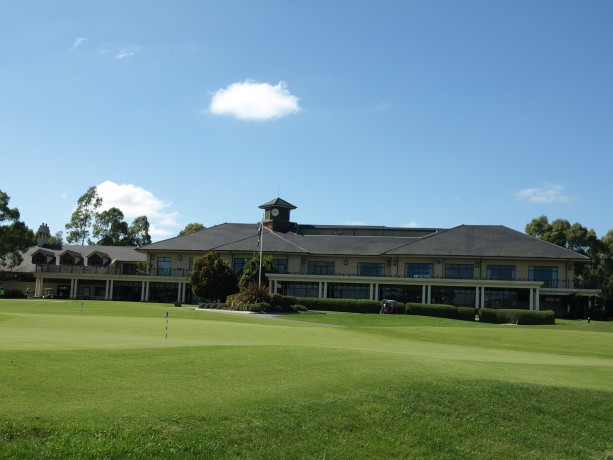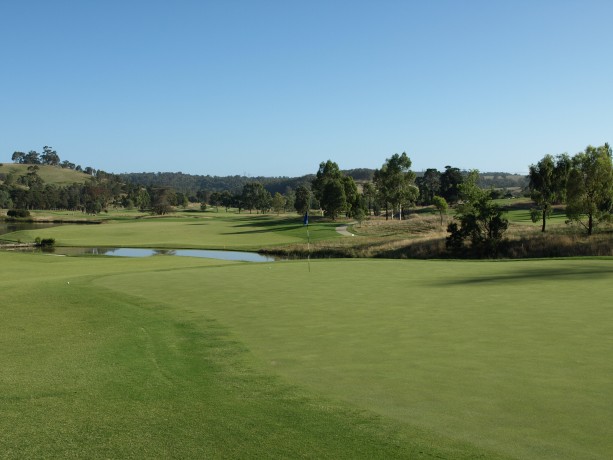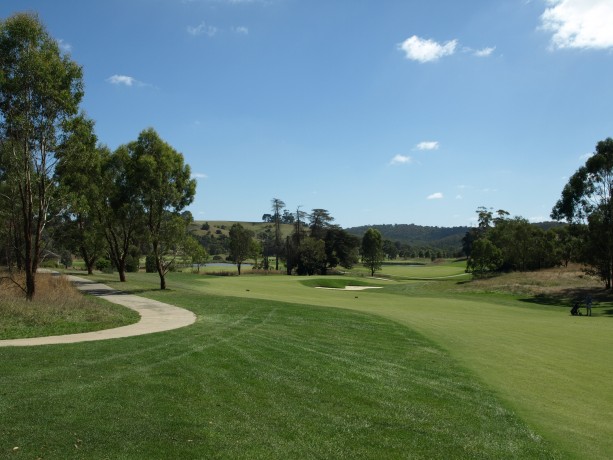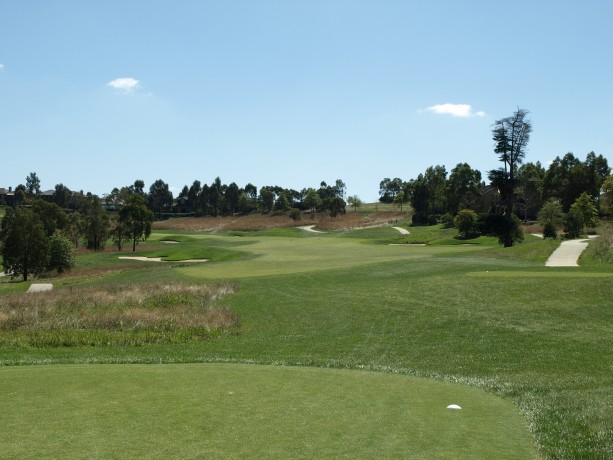
Location: Chirnside Park, VIC
Established: 2000
Architect: Jack Nicklaus
First Played: 10th Mar 2015
Last Played: 10th Mar 2015
Magazine Ratings

97 (Current)

57 (2014)
The Heritage Golf & Country Club has been a course I have struggled to get a game on for a while, so when an open day appeared in my email from The Social Golf Club, I didn’t hesitate to jump at the chance to play the St Johns course. My golf buddy James came along as he was hoping to tame the course after losing out on their last battle.

Entrance to The Heritage Golf & Country Club
The Heritage Golf & Country Club opened in 1999 with the release of residential development. The St Johns course, the first private Jack Nicklaus ‘Signature’ golf course to be built in Australia, opened a year later. Stage two of the development saw the Henley Course open in 2006, designed by Tony Cashmore, leaving two championship courses as a part of the club.

Clubhouse at The Heritage Golf & Country Club
The club locker room boasts some of the great names of Australian golf, including Aaron Baddeley and Brett Ogle.

Course map for The Heritage Golf & Country Club St Johns Course
As we were playing with The Social Golf Club, it was an early morning shotgun start with around 80 in the field. Luckily we started on 17 so it wasn’t too far to travel, except it was to the highest part of the course we had to travel.

The Heritage Golf & Country Club St Johns Course Scorecard

Hole 1 – 304 meter par 4
This short par 4 is a great way to start the round, except we started on 17, but lets pretend this was the first hole. A wide fairway should be easy to hit, shouldn’t they all then. Bunkers are located either side of the fairway, so right of the middle would be a good option as it leaves the best angle to the green.

1st Fairway bunker restoration
The green keepers were busy working at cutting back the rough grass around the bunker edge. Not sure if this is change to course setup or lack of maintenance. However with the amount of green keepers working I would say it is change of setup.

The slightly contoured 1st green
This green is angled to allow shots from the right of the fairway to have the best approach. A small gully with rough grass, separates the fairway from the green complex.Two bunkers are located on the right of the hole.

Hole 2 – 380 meter par 4
The second hole looks challenging and is ranked so, being the second hardest hole on the course. From the tee the landing area angles to the right, with a potential water carry required depending on your shot shape. A few bunkers are scattered along the left of the fairway.

A forced water carry to the 2nd green
The approach shot to the green requires a carry over water running along the length of the green. Numerous bunkers also run along the bank of the water. Again there looks to be overdue maintenance underway removing heavy grass along the waters edge, but maybe it is just signifying fairway, a bit undecided on this. Removal of excess grass will be useful as one of my playing partners hit the bank and we were unable to find the ball, not knowing if it rolled in or was lost in the grass above the hazard markers.

Looking back from the 2nd green
This green is slightly sloping from the left to right.

Hole 3 – 154 meter par 3
This mid length par 3 has bunkers running on either side of the green, but heavily on the center right of the green complex. The ground generally slopes downhill from the left, where an opening can be found to run the ball onto the green.

The large 3rd green
This green is quite large with a contour running through the center, but right of that slopes away.

Hole 4 – 482 meter par 5
The longest hole on the course, this par 5 requires at least two well struck shots to reach the green. From the tee water runs most of the right hand side with one bunker in play from the tee. A pot bunker is also located on the left, which if carried gives more length to the drive.

Carry the cross bunkers on the 4th fairway
The second shot will ideally carry the cross bunkers located before the green. Landing in these will leave a difficult approach. Ideally carrying these will leave a clear view of the green.

The 4th green
This green slopes from the middle, away to the front and rear. This leave a ridge to carry or putt over when making the approach. If the pin is in the rear section it is better to play long than leave the ball above the hole.

Hole 5 – 396 meter par 4
This long par 4 is a fairly straight hole with out of bounds running down the left side. A large bunker is located on the right which is in range from the tee. A small pot bunker is also on the left, which I was lucky enough to stop up against the face leaving no shot to the green.

Slightly contoured 5th green
The fairway slopes to the right, with a bunker short of the green on the left, to catch anyone running the ball into the green, as well as a trap in front of the green.

Hole 6 – 336 meter par 4
This hole requires an accurate tee shot avoiding the bunkers either side of the fairway to allow a clear shot to the green.

James enjoying his day at the beach
After having a beautiful drive down the middle, James struck issues after his second shot, finding two bunkers on the hole. Here he is playing out of the bunker behind the 6th green.

The well protected 6th green
Water is in play for the approach shot to the green, which also has two traps protecting the front and another at the rear.

Hole 7 – 125 meter par 3
This shortish par 3 plays uphill and looks great from the tee. The easiest hole on the course has a pot bunker located at the front with openings either side to the green. Another two traps are located at the the rear left, protecting any rear pin positions. The ground in front of the green slopes from the right and away.

The long 7th green
As for the putting surface, it has some gentle contours but is quite long and narrow. This favours a right to left shot from the tee.

Hole 8 – 370 meter par 4
This longer par 4 is deceiving from the tee, blocking out some of the fairway available to the right, due to a mound near the tee. Bunkers are reachable on either side as the fairway narrows. The ground slopes from the right and runs down to the water located along the left of the fairway.

Massively undulation 8th green
The approach has to take into account many things, bunkers running along the front of the green down to the left portion, ground sloping from the right and also the two tiered green. There is a steep slope separating the two tiers. If the pin is located on the left portion of the green and the approach stays on the top section, it will be impossible to leave the ball anywhere near the hole.

Hole 9 – 468 meter par 5 – Playing partner Clive taking aim
This mid-length par 5 plays around the lake located on the left. A slightly intimidating tee shot has water left as well as bunkers, whilst the right has a couple of bunkers which sees the fairway end. Playing over the left bunkers is the ideal line to try and reach the green in two.

Skirting the water on the 9th – the ideal position to reach in two
If the bunkers have been carried the line to the green is more open to reach with the second shot. If not play to the right of the green where there is plenty of room to safely land the ball, but leave a more difficult approach to the green.

Narrow opening to the 9th green
Two bunkers are found on both sides of the green to catch any wayward shot. This also makes it more difficult if approaching from the side.




Hole marker and various wildlife found at The Heritage Golf & Country Club

Hole 10 – 325 meter par 4
Starting the back nine, there is a mid size par 4. This has fairway traps either side but also a large tree down the left. Ideal line is to the right, which avoids the trees and has the best angle to the green.

10th green – looking from the 18th fairway
A forced water is in play the entire length of the green, leaving a difficult approach shot. There is a section of fairway to the right of the green. The putting surface is small but has strong contours.

Hole 11 – 163 meter par 3 – James teeing off
This is the longest and hardest par 3 on the course, with a forced water carry of at least 100 meters a. Those not making this carry have a drop zone on the other side of the water.

The long 11th green
This green measures almost 40 meters in length and sits at the base of an old quarry site. If the tee shot hits the wall it could end up anywhere. Landing in the correct portion of the green is essential to ensure 3 or more putts are not required.

Hole 12 – 458 meter par 5
The easiest par 5 on the course has one of the most dramatic tee shots. Playing from an elevated tee, there is plenty of fairway to hit. A pot bunker is located in the center which the long hitters can carry. Water runs the entire length of the hole to the right.

Playing from the 12th fairway
The second shot to the green has to carry cross bunkers to either reach the hole or leave an easy approach.

Another long green is found on the 12th
Bunkers are located to the left of the green, whilst the putting surface has some small undulations.

Hole 13 – 324 meter par 4
This hole plays longer than the yardage due to the large rise in the fairway. With a dogleg to the right, reaching the far point of the fairway has a 15 meter rise. A large bunker in a deep hollow is located on the right of the fairway.

Approach to the 13th green
The approach shot to the green will vary depending on the length of the drive. Shorter hitters will still have an uphill shot, whilst the longer hitters will have a fairly level playing area. Another bunker is found on the front right section of the hole. The putting surface has a ridge through the center which runs away to the rear.

Hole 14 – 344 meter par 4
The tee shot is one of the first to not have bunkers in play, however the fairway narrows between trees on either side.

James playing to the 14th green
The green has a bunker to the right, but plenty of space to the left. This green slopes from the left to the right.

Hole 15 – 476 meter par 5
The last par 5 for the day, this hole runs along side water down the left and is opposite the 12th hole. From the tee bunkers are in play on the right which need to be avoided, although this is near the best angle for your tee shot to take advantage of the slope and gain more distance.

The 15th green
Playing the approach has further bunkers in play on the left and a small pot in the center. Safety can be found on the right of the green, whilst a bunker is located behind the green.

Hole 16 – 357 meter par 4
Starting to close the round out with two of the hardest par 4 holes on the course, the 16th plays up a gentle slope all the way to the green with six meter rise. The hole doglegs to the left and has two bunkers in play from the tee.

Approach shot to 16th fairway
Playing to the 16th green is best approached from the right side. Bunkers cover the left side of the hole with one small bunker to the right. The tricky part is the green itself. Sloping from the right to the left with a gentle slope which cannot be seen from the front of the green.

Hole 17 – 153 meter par 3
The medium length par 3 played at the highest point on the course. From the tee you must avoid the bunkers to the left of the hole as it will leave a difficult shot up to the green. One bunker is also found to the right trying to play safety, but avoid the thick grass found on this side.

The 17th green with the 16th in the background
This green has some slight undulations and is long and narrow.

Hole 18 – 406 meter par 4
Finishing the round on the hardest hole, the tee shot is from an elevated position. The hole doglegs to the right and has bunkers on this side also. To the left heavy grass is found which could result in a lost ball.

Approach to the 18th green
We are left with a long approach shot even if you have carried the fairway bunker. Further trouble is located left with numerous bunkers leading up to the hole. The green is quite wide but very narrow. Par here is a great result and should result in celebratory shout of drinks for your group.
In summary this was a great course to play, but very demanding at times. The condition of the course was spectacular and there was a great variety in the hole types and lengths. It was a long course so short hitters might struggle to carry some of the distances required, especially a couple of the forced carries. The back nine was very hilly, so left our unfit group gasping for air, leaving us to think a cart would be a good idea if we played again. I did notice quite heavy grass on the edges of some bunkers but this was being cut back by the green keepers. Evidence of further grass being removed along the bank of the water on the second had been partially completed. Unsure if this is a design change, lack of maintenance, or clean up after hosting of a tournament. This will be a big improvement on the course when completed.
I would certainly enjoy playing the course again, but also look forward to playing the Henley course in the future.
Knowing that this club has gone into receivership three times, leaves me wondering about the business model the club is following. Being so far out of the city and numerous other clubs moving to the area, I don’t know how The Heritage can survive by not allowing public onto the course, unless this has changed without my knowledge.
How to play The Heritage Golf & Country Club:
1. Be invited by a member
2. Stay at the accommodation on site
3. Play one of the open days held throughout the year. Keep an eye out on The Social Golf Club

